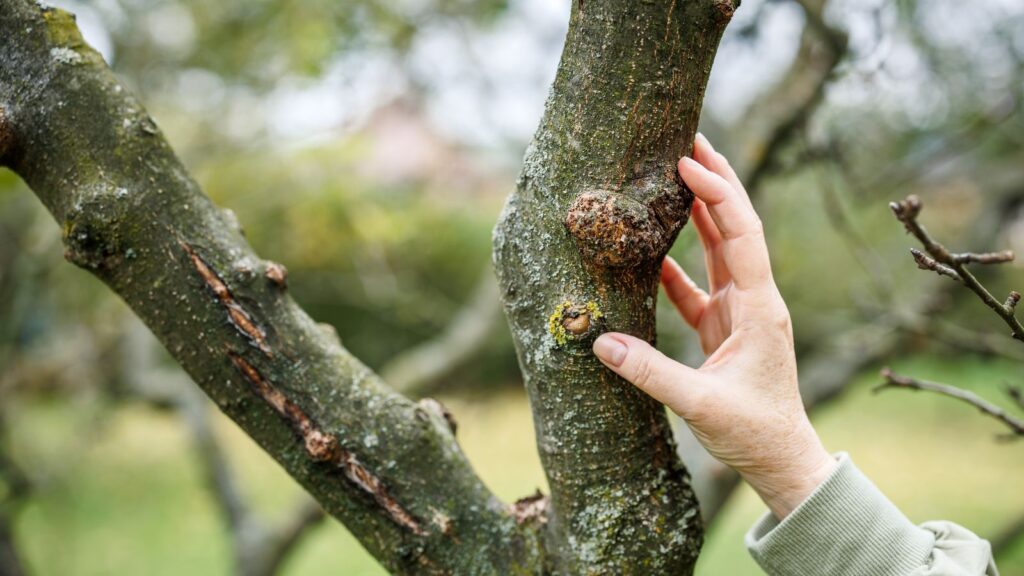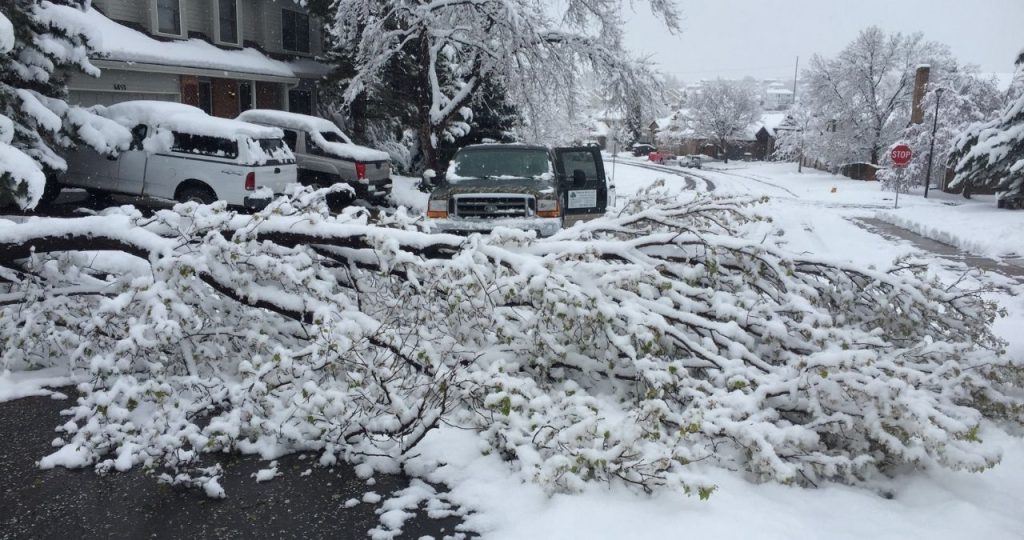Fall tree diseases can quickly take the shine off the season. While cooler weather brings cozy sweaters and pumpkin patches, it can also bring trouble for your trees. Tree health often takes a hit as common diseases crop up, and some can turn serious if you don’t catch them early. The most common fall tree diseases to watch for in Nebraska include cedar apple rust, apple scab, and several fungal infections that damage leaves and branches.
Leaf spots, odd discoloration, and leaves that turn brown or drop too soon often appear first. It’s easy to mistake these symptoms for normal fall changes, but that’s not always the case.
Spotting these issues early can help your trees and shrubs survive the winter and bounce back strong next spring.
Fall Tree Diseases to Watch For in Nebraska
Common Fall Tree Diseases in Nebraska
Several common tree diseases appear during the fall growing season in Nebraska. From leaf spots and rusty blotches to branch dieback, the warning signs often add up until the whole tree looks “off.”
When you recognize these signs early, you stand a much better chance of keeping your trees healthy.
Anthracnose
Anthracnose is one of those common fungal diseases that infects leaves of oaks, maples, and a few other favorites. You’ll spot dark, weirdly shaped spots or blotches on leaves, and sometimes they even curl or wilt.
Leaves might turn brown along the edges, and if this keeps up, you’ll see twig dieback and stunted growth. If you’re dealing with anthracnose, rake up and remove fallen leaves, and maybe consider a fungicide if things get out of hand.
Cytospora Canker
Cytospora canker likes to target spruce, poplar, and cottonwood. Look for sunken, dark cankers on branches or trunks, often with a telltale ooze of gummy resin that’s especially noticeable during fall.
It weakens branches and, if it hits the trunk, can kill the tree. Usually, it goes after trees already stressed by drought or injury. Prune out infected branches and keep the tree’s root systems healthy with good watering and mulch.
Dutch Elm Disease
Dutch elm disease is a nightmare for elm trees in Nebraska, spread by bark beetles. You’ll see leaves yellow and wilt, usually on one branch or side first.
Those leaves drop early, and if the infected tree isn’t treated, it can die in just a few weeks. Remove and destroy infected wood during fall or winter, and in trouble spots, you might need insecticides or fungicides to protect healthy elms.
Thousand Cankers Disease
Thousand cankers disease goes after black walnut and some other walnuts. Walnut twig beetles spread the fungus, and you’ll notice tons of tiny cankers that eventually girdle branches.
Leaves yellow, the crown thins, and branches die off, especially noticeable in the fall. There’s no cure, so you’ll need to act fast: remove affected branches or the whole tree, and don’t move infected wood around.
Identifying Signs and Symptoms
While trees don’t speak, they do send signals: wilting leaves, roughened bark, or a drop in vigor. Recognizing these warning signs early gives you a head start on protecting their health.
Leaf Discoloration and Spotting
Keep an eye out for leaves that turn yellow, brown, or develop leaf spots. For instance, apple scab usually causes olive-green or brown spots, while anthracnose creates dark, irregular blotches.
Sometimes these leaf spots feel rough or scabby. Discoloration can start at the edges or just take over the whole leaf. Eventually, those leaves weaken and drop before their time.
Look for things like yellow halos or merging patches. Wet fall weather in Nebraska really ramps up these leaf spot diseases.
Unusual Bark Changes
Bark tells a story, too. Cracked, peeling, or sunken bark, or spots with reddish brown or dark stains, are all red flags.
If you see oozing sap or gummy stuff, there’s probably an infection brewing inside. Dead bark patches (cankers) can block nutrients and weaken the tree and shrub further.
Bark issues usually start small and spread, so don’t just glance; inspect closely in the fall. Damaged bark also opens the door for pests like the emerald ash borer or more diseases.
Premature Leaf Drop
If leaves are bailing out before they should, something’s up. Early leaf drop saps the tree’s energy reserves before winter.
Often, these leaves are yellowed, spotted, or dried out. Sometimes pests or infections push the tree to drop leaves early as a defense. In Nebraska, keep an eye out for this, especially if you see it along with other symptoms of fungal disease or root stress during the fall growing season.
Prevention and Management Strategies
Fall care is all about stopping the spread, keeping tree health up, and picking the right trees for Nebraska’s quirks. These steps lower infection risks and help trees bounce back.
Proper Pruning Techniques
Prune dead or infected branches in the fall to reduce disease. Always use sharp, clean tools—don’t give pathogens a free ride.
Cut at the branch collar, not flush with the trunk, so wounds heal right. Try to prune early in fall, before heavy leaf drop, so wounds dry out and fungus doesn’t get a foothold.
Skip pruning when it’s wet or freezing. Disinfect your tools between cuts with bleach or alcohol, especially if you’re dealing with oak wilt or anthracnose.
Sanitation and Debris Removal
Don’t let fallen leaves, twigs, or fruit pile up, as they can be a breeding ground for diseases. Rake up and throw out anything with leaf spots, powdery mildew, or blight.
Avoid composting infected debris, since lingering spores can overwinter and spark a fresh outbreak the following season. Keep the area around the tree base clear to prevent root infections and discourage pests.
Better airflow means less humidity, which means less fungal growth. It’s simple but makes a big difference.
Selecting Disease-Resistant Tree Species
If you can, plant trees that resist the usual suspects in Nebraska. Oaks tend to hold up well against many common tree diseases and pests.
Check with your local extension service or nursery. They’ll know what works for your spot. Mixing up species in your yard or landscape also helps stop disease from spreading like wildfire.
Pick trees that can handle drought and local soil, too. Stressed trees are way more likely to get sick during the fall growing season.
Factors Increasing Fall Disease Risk
Some things just make it easier for fall tree diseases to get a foothold. Drought, weather damage, and overcrowding all chip away at a tree’s natural defenses.
Drought Stress and Tree Health
Drought is all too common in Nebraska. When trees don’t get enough water, leaves might develop brown spots or scorched edges.
This makes the tree more vulnerable to pests and fungal infections like verticillium wilt or cankers. Give your trees a good soak before winter to help them recover and stay strong.
Weather-Related Damage
Fall can bring wind, frost, or heavy rain, sometimes all at once. Broken branches or torn leaves become entry points for diseases like Dutch elm disease or oak wilt, both of which kill trees fast.
Freezing temps can mess with bark and root systems, leaving trees open to infections or pests like the emerald ash borer. Injuries before winter just make things worse.
Overcrowding and Poor Airflow
Trees packed too tightly don’t get enough air or sunlight. That extra moisture is a dream come true for fungal diseases that infect leaves and bark.
Overcrowded trees also let pests hop from one tree to the next. Give your trees space so air can move and sunlight can dry things out, a simple fix that helps a lot.
Frequently Asked Questions
What are the common symptoms of Dutch elm disease in Nebraska’s elm trees?
Dutch elm disease infects leaves, making them yellow, wilt, and curl. Infected trees often drop their leaves before they should. Peeling back the bark can reveal dark streaks, clear signs of serious vascular damage.
How can you identify oak wilt in Nebraska, and what are its treatment options?
Oak wilt shows up as browning at the leaf edges, especially on red oaks. Leaves wilt and drop in a hurry. Cut out affected branches, use fungicides if you have to, and trench around trees to block root grafts that spread the disease.
What steps should be taken to prevent apple scab in Nebraska’s apple trees?
Pick up and dispose of fallen leaves and fruit. Start fungicide treatments early in the season. Good pruning helps with airflow, which makes things less cozy for the fungus.
Are there any new emerging tree diseases in Nebraska we should be vigilant about?
Pine wilt disease is showing up more often. It’s caused by a nematode and can kill trees shockingly fast. Catch it early and remove infected trees right away to slow the spread.
How does anthracnose manifest in Nebraska’s trees, and what control measures are effective?
Anthracnose causes irregular, dark leaf spots and can make leaves drop early, especially after wet weather. Remove fallen leaves and treat with fungicides as soon as you spot symptoms.
What is the best way to manage pine wilt disease in Nebraska’s pine trees?
Pine wilt hits hard in Nebraska, especially during the growing season. If you spot a pine that’s turned brown or dropping needles fast, that’s a red flag for this disease.
The best thing you can do? Remove and destroy the infected tree right away. This stops the nematode from spreading to healthy trees and protects your whole tree and shrub collection.
Choosing resistant pine species for new plantings can make a big difference. It’s a smart move if you want to avoid common tree diseases like pine wilt, verticillium wilt, or even oak wilt, which kills trees across the Midwest.
Don’t forget to monitor your trees for symptoms. Look for leaf spots, needles turning reddish brown, or other signs that the disease infects leaves and root systems. Regular checks help you catch issues before they spread, especially with fall tree diseases to watch for in Nebraska.
For more info on pine wilt, common fungal diseases, emerald ash borer, or fall tree diseases, check out resources from the USDA Forest Service. They’re a solid source for tackling leaf spot diseases and keeping your tree health in check.
Tree Services of Omaha – Tree Removal Services
Tree Services of Omaha, Nebraska is a full-service tree care provider that offers a wide range of arborist services, including but not limited to: Tree Removal Services, Tree Trimming, Tree Pruning, Tree and shrubs Shaping, Stump Removal, Stump Grinding, Emerald Ash Borer Treatment, Arborist Consultations, Systemic Tree Injection (Tree Healthcare).
Contact us today for a free estimate!



